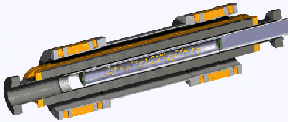Alone or in company, protons are built to last. Not so neutrons.

While protons will endure far longer than the age of the universe, a loose neutron bids adieu in only minutes to hours, experiments have shown. The neutron’s swan song, a process called beta decay, transforms the particle into a proton, an electron, and an antineutrino.
However, neutrons in stable nuclei last indefinitely.
To date, the world’s best value for the neutron lifetime—a term indicating how quickly a population of free neutrons decays—is 886.7 seconds, plus or minus 1.9 seconds, or roughly 15 minutes. After one lifetime, more than 60 percent of the free neutrons in a sample will have disintegrated. Seeking to make the measurement 10 to 100 times more precise, a team of American and German physicists has now demonstrated a way to magnetically trap neutrons and clock their decay.
The neutron lifetime affects estimates of the amount of the light elements, such as hydrogen and helium, formed shortly after the Big Bang. A more exact figure may also shed light on an apparent discrepancy in experimental measurements of the so-called weak force, which governs beta decay.
Laser cooling and other atom-cooling methods devised in the past 15 years don’t work on neutrons since the particles only weakly interact with other matter and light. Neutrons are also much harder than atoms to grip with a magnetic field.
Trapping neutrons magnetically has proven to be “quite difficult,” says Paul R. Huffman of the National Institute of Standards and Technology (NIST) in Gaithersburg, Md. Only by injecting a neutron beam into a cylindrical chamber filled with superfluid helium-4 chilled almost to absolute zero did he and his colleagues capture a few hundred neutrons.
Huffman and his coworkers describe the trap in the Jan. 6 Nature. Meanwhile, an earlier NIST effort to measure neutron lifetime in a different way continues (SN: 5/6/95, p. 278).







